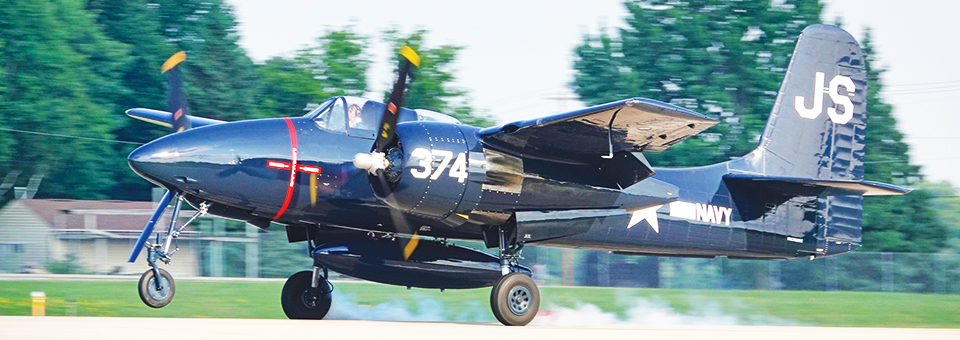A Tail of Two Kitties: F7F Tigercats
Duo of warbird fighters made for immersive Warbirds in Review session
By Frederick A. Johnsen
July 27, 2018 - The only thing better than one F7F Tigercat at EAA Air Venture 2018 is two Tigercats, and warbird owner Jim Slattery has two of the big fighters here. They were the draw for a varied discussion in the Warbirds in Review program Thursday afternoon.
The event began with a thrilling video created Monday at AirVenture as one of the Tigercats lost much of its left main wheel as it rolled out on the runway. The remaining part of the magnesium wheel blossomed into flame as veteran warbird pilot and EAA Warbirds of America President Connie Bowlin kept the crippled fighter under control. Owner Jim Slattery watched the video on a big screen and said to the crowd of several hundred: “Well, I don’t know if I’ll ever lend Connie Bowlin an airplane again.” As the crowd’s laughter subsided, Jim complimented Connie on her handling of the big Tigercat, saying she turned “what could have been a real tragedy into a minor inconvenience for the fire department.”
That F7F, sporting a new replacement wheel assembly, was on display for the session. Connie was scheduled to fly it at AirVenture again. The Tigercats came to Oshkosh by way of the National WWII Museum aviation in Colorado Springs, Colorado. Bill Klaers, president of WestPac Restoration and a co-chairman of the museum, said the F7F never realized its design mission because World War II ended when it did. He said the F7F was designed as a quick climbing interceptor to block kamikaze aircraft attacks on the U.S. Navy. The Tigercat’s impressive combat climb rate of 4,500 fpm can be bested by current warbird F7Fs, no longer burdened with the weight of combat equipment. Bill championed the F7F as a tribute to engineering and manufacturing greatness in the U.S. because what’s considered state of the art in aviation went from biplanes to the fast fighter on display in just a few years.
Bill told the crowd about the museum’s extensive and growing education program, in which teachers as well as students learn about World War II to a degree that they otherwise might not in school.
Author Adam Makos told the crowd about the Tigercat’s subsequent nocturnal combat career as a radar-equipped night fighter and interdiction fighter over Korea. North Korean bridges and narrow gauge railroads suffered the wrath of F7Fs. When the communists used slow Po-2 biplanes as nuisance bombers over Allied lines at night, fast fighters had a difficult time finding and engaging the 95 mph biplanes. So Tigercats, which could fly slower than some of the jets, used their radar to find the raiders, which the F7Fs then downed, Adam said.
The two Tigercats here at AirVenture have consecutive serial numbers. They are part of an elite roster of only seven F7Fs currently flying.





